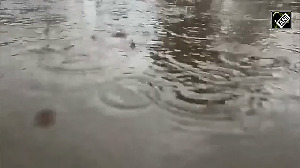The outdoor media in Delhi is back. Between 1997, when hoardings were banned in the city, and now, the billboard prices have shot up by about 500 per cent. And as advertisers vie for space on bus shelters, hoardings, unipoles, and public conveniences, Delhi's Rs 80-crore (Rs 800 million) outdoor advertising market is set to cross the Rs 150 crore (Rs 1.5 billion) mark by the end of 2005.
According to TAM's advertising mapping division, AdEx, the all-India outdoor spends went up from Rs 790 crore (Rs 7.9 billion) in 2003 to Rs 850 crore (Rs 8.5 billion) in 2004.
Outdoor experts claim that the shortage of billboards has pushed the hoardings prices up. Today a bus shelter, that cost Rs 5,000 before the ban, costs nearly Rs 30,000 a month. The massive (60/20ft) hoarding at the Blind School (near the Oberoi flyover) is priced at Rs 400,000 a month -- this was available for Rs 75,000 in 1997.
The price escalation is attributed to increasing demand for hoardings as well as intense competition among advertisers.
"If LG takes a billboard in Connaught Place for Rs 400,000 a month, Samsung doesn't mind paying that much, if not more," says Umesh Puri, director of Gold Star Communications.
In 1997, the outdoor industry in Delhi suffered a major blow following the Supreme Court order directing the Municipal Corporation of Delhi, NDMC, Railways, Public Works Department, Delhi Police and the Delhi Cantonment Board to "remove all hoardings on road sides which are a disturbance to safe traffic movement."
While the agencies were required to identify and remove only the hazardous hoardings, they implemented a blanket ban on billboards, points out Pramod Bhandula, director of Selvel Advertising and a member of the Delhi Outdoor Advertising Association.
The move killed the city's bustling outdoor industry and snuffed out a source of revenue for the government. Outdoor experts claim that the government earned close to Rs 100 crore (Rs 1 billion) a year in 1997. Today, its revenue is not more than Rs 15 crore (Rs 150 million).
However, the MCD set up an Urban Graphics Forum on April 30, 2003. The objective of the body was to regulate the outdoor advertising media in the city. The graphics forum has now identified new adjuncts (advertising junctions) at South Extension, Pitampura, Red Fort and Defence Colony Flyover in the city. The tenders for these sites have yet to be floated.
To further boost the city's outdoor business, the NDMC has floated global tenders for building 200 world-class bus shelters on a Build-Operate-Transfer basis. The bus shelters will be leased for 15 years.
Planning versus commerce
The Urban Graphics Forum comprising urban planners, graphics designers, outdoor advertisers and key MCD officials was set up two years ago to monitor outdoor advertising in Delhi.
But the outdoor media agents complain that the forum is bureaucratic. Tenders for the new advertising sites, identified more than six months ago, have not been floated.
"MCD is losing revenue because of such delays," points out Mukesh Gupta, director, Graphis Ad. Adds Selvel's director Pramod Bhandula: "Fresh bids for subway spaces are being invited on April 26 but contracts for earlier bids are still not awarded." Gupta and Bhandula are members of the graphics forum but say that they are hardly ever invited for its meetings.
MCD commissioner Rakesh Mehta says the grouse unwarranted: "Delhi outdoor association members have been included in the forum only for their limited technical inputs. Increasing revenue is not our main concern. The objective is to improve the urban landscape. If advertisers had their way, they would park a trailer hoarding in the middle of Chandni Chowk."






 © 2025
© 2025